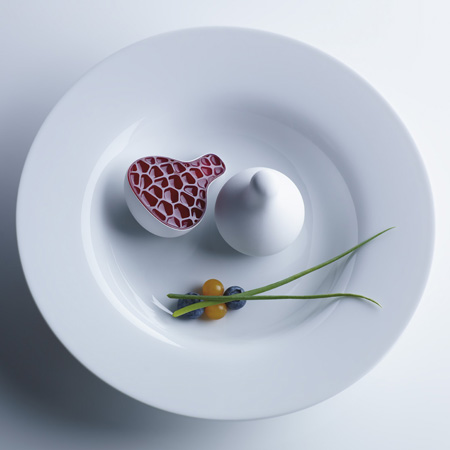Philips Design in Eindhoven have designed a series of conceptual products for food, including a machine (below) that prints combinations of ingredients into shapes and consistencies specified by the user (above).
The device, akin to a rapid prototyping machine for food, was conceived as part of the company's Design Probes scheme, which investigates how we may live in 15-20 years' time.
Foods would be constructed from ingredients corresponding to the nutritional needs of the user, using a similar process to rapid prototyping.
It could be used in conjunction with two other innovations envisaged as part of the same project: a scanning wand for analysing the user's individual nutritional needs and the nutritional value of food items, and a system for farming in the home.
Here's some more information from Philips Design:
--
Info On Project
Philips Design's ongoing design probes program has been further extended with three explorations into the area of food.
These projects - Diagnostic Kitchen, Food Creation and Home Farming - take a provocative and unconventional look at areas that could have a profound effect on the way we eat and source our food 15-20 years from now.
New ways of looking at food
"We were very interested in new ways of looking at what we eat and the processes that food undergoes before we consume it," says Clive van Heerden, Senior Director of design-led innovation at Philips Design.
These investigations took into consideration wider societal trends like the shift in emphasis from curative to prevent medicine, the growth in popularity of organic ingredients, genetic modification, land use patterns in growing food, the threat of serious food shortages and rising food prices.
Three interlinked areas of exploration were identified: the Diagnostic Kitchen, Food Creation and Home Farming.
Proper analysis of our diets
The Diagnostic Kitchen concept allows people to take an accurate and personally relevant look at what they eat. Rather than relying on general information like 'recommended daily intake' it becomes possible to scan food and analyze how well its contents match your current needs.
By using the Nutrition monitor, consisting of a scanning ‘wand’ and swallowable sensor, you could, for example, determine exactly how much you should eat to match your digestive health and nutritional requirements.
It would also be possible to use the monitor to analyze food in the shops before deciding what to buy.
All of this would obviously be of enormous benefit for those trying to maintain a healthy lifestyle.
Food printing
The second exploration area, Food Creation, has been inspired by the so-called 'molecular gastronomists.' These chefs deconstruct food and then reassemble it in completely different ways, so for instance you could be served carrot as foam or parmesan cheese as a strand of spaghetti.
"We wanted to examine how you could take this idea further in the domestic environment" says van Heerden. This led to the concept of a Food printer, which would essentially accept various edible ingredients and then combine and ‘print’ them in the desired shape and consistency, in much the same way as stereolithographic printers create 3-D representations of product concepts.
The nutritional value and relevance of what was being 'printed' could also be adjusted based on input from the diagnostic kitchen’s nutrition monitor.
Growing food in the living room
Home Farming, as the name suggests, explores growing at least part of your daily food inside your house. "People are increasingly concerned about how their food has been manipulated and processed, genetic modification, global shortages, environmental degradation through monoculture, the distance food travels before reaching their plates and many other related issues," says van Heerden.
“One way of addressing such legitimate concerns is to source the food yourself by having a biosphere in your living room.” This Biosphere home farm contains fish, crustaceans, algae, plants and other mini-ecosystems, all interdependent and in balance with each other. Making families all over the world at least partly self-sufficient in this way has obvious appeal.
Stimulating discussion
The intention, as with all probe programs, is to elicit reaction and provoke discussion which can be used to further refine the ideas.
About the probes program
The Philips Design probes program is a unique foresighting initiative which tracks emerging developments in five main areas - politics, economics, environment, technology and culture. The outcomes of this 'far-future' research are used to identify systemic shifts that could affect business in years to come and that could lead to new areas in which to develop intellectual property.

